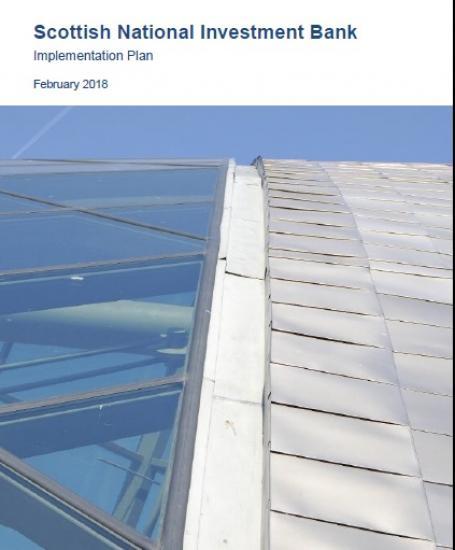Scottish National Investment Bank - Former Tesco Bank CEO appointed as strategic adviser.
23rd June 2018

The First Minister has appointed Benny Higgins as the strategic adviser for the establishment of the Scottish National Investment Bank.
Mr Higgins, former CEO of Tesco Bank, developed an implementation plan for the bank and the Scottish Government has accepted all 21 of his report's recommendations. His new role will build on this work.
As strategic adviser, Mr Higgins will play the leading role in the development of the bank, providing advice to and working with the First Minister and other ministers, and building support for the bank among civic and business organisations.
He will also work closely with the Scottish Government's programme director to establish the foundations required to ensure the National Investment Bank drives innovation and accelerates the move to a low carbon, high-tech, connected, globally competitive and inclusive economy.
First Minister Nicola Sturgeon said:
"Benny Higgins appointment to drive forward the work on the Scottish National Investment Bank will see him build on the invaluable work he did to develop the implementation plan for the Bank, recognising the unique skills and insights he will bring to the delivery programme.
"Benny brings the extensive financial sector experience this project requires combined with a clear commitment to deliver a mission-driven investment bank that can help transform our economy.
"An early priority will be to bring together stakeholders from across the public and private sectors to inform the final proposals that will be included in legislation to establish Scotland's National Investment Bank.
"The bank is a hugely exciting development for Scotland and I look forward to working with Benny Higgins to establish it as the cornerstone financial institution in Scotland's economic architecture, promoting and providing finance to help achieve our economic ambitions."
Benny Higgins said: "The creation of The Scottish National Investment Bank will be an essential element to underpin the future economic well-being of our country. Hard yards lie ahead, but I relish the challenge that the First Minister has set us. We will build an institution that is fit for purpose and, in particular, one that has the right values."
The bank will take a mission driven approach to provide finance and catalyse the investment required to achieve a step change in inclusive growth for the Scottish economy, and will be supported by long-term capitalisation of at least £2 billion over the first ten years.
Mr Higgins' appointment will start in late July and will end in early 2020.
From The Report
The Bank should be capitalised over time by the Scottish Government. An early commitment to this has been made by the Scottish Government in the 2018-19 Draft Budget with an
undertaking to provide initial public capital of £340m for 2019-20 and 2020-21. The Draft Budget also established a new £150m Building Scotland Fund (£80m in 2018-19 and £70m in
2019-20). It is proposed that this fund's remit, and investments made, transfer to the Bank in 2019-20 when it is operating in interim or ‘shadow’ form, pre-incorporation.
To achieve a step change in the supply of finance, the target level of public capital for the Bank should be a minimum of £1bn over the first five years and a further £1bn over years 6 to 10 (this excludes the funding of the existing financing activities to be brought under the remit of the Bank). A public capitalisation at the level of £2bn - equating to around 1.3% of Scotland’s GDP – is in line with international comparators.
The Bank should reinvest its financial returns, both capital and interest, to create a selfsustaining, lasting institution with increasing influence on the Scottish economy. To achieve this ambition, there are three key milestone objectives:
● To secure a dispensation from HM Treasury to have the flexibility to manage, retain and carry-forward cash balances over financial year-ends. This is required by the time the Bank is established
● To be self-funding, meaning that the Bank covers its operating costs from investment returns. Given the longer term investment horizon of the proposed investment activities, this objective may not be achieved until the medium-term
● To be able to raise capital in its own right and no longer be reliant on capital advances from the Scottish Government to fund its investments. Further dispensation from HM Treasury will also be required for this.
Read the SNIB implementation plan in full at - http://www.gov.scot/Publications/2018/02/5676
Executive Summary
The Council of Economic Advisers highlighted the need for strategic patient capital to boost business investment and innovation and to support our long term growth ambitions. The Scottish Government's 2017-18 Programme for Government committed to establishing a Scottish National Investment Bank to boost Scotland’s competitiveness and realise the Scottish Government’s ambitions for the economy by providing patient capital to finance growth. This commitment was made on strong international evidence that national investment banks of scale can lead to a strong, positive impact on investment, innovation and long-term economic growth. By making strategic investments and nurturing new industrial landscapes, their focus on solving important societal challenges (a "mission-oriented" approach) has helped other countries to rebalance their economies and reinvigorate their industrial base. These institutions act in concert with their governments and other public sector institutions to help achieve long term objectives.
This Implementation Plan provides recommendations on the establishment of a Scottish 'National Investment Bank' and covers a variety of topics including:
-The role of existing national promotional banks
-Alignment to Scottish Government policy
-The Bank's vision and mission based approach
-Proposed financial activities
-Classification and capitalisation of the Bank
-Suggested governance structures
-A recommended transition plan
